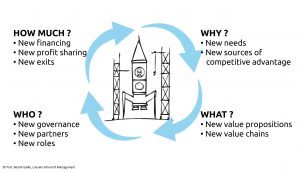 Designing or improving a successful business model, business planning, means on one hand building and validating a credible story regarding how specific resources could be (better) mobilized to solve a specific problem and on the other hand selling that story to the relevant internal and external stakeholders.
Designing or improving a successful business model, business planning, means on one hand building and validating a credible story regarding how specific resources could be (better) mobilized to solve a specific problem and on the other hand selling that story to the relevant internal and external stakeholders.
 A business model will be convincing if its design addresses in a consistent way four key questions: 1) Why is there a problem and why are we well positioned to solve it? 2) What exactly could be sold to whom and how? 3) Who needs to be mobilized? 4) How much is at stake?
A business model will be convincing if its design addresses in a consistent way four key questions: 1) Why is there a problem and why are we well positioned to solve it? 2) What exactly could be sold to whom and how? 3) Who needs to be mobilized? 4) How much is at stake?
 Finding new ways to address the why, what, who and how much key questions around the same innovation opportunity can allow managers to design innovative (and more sustainable) business models.
Finding new ways to address the why, what, who and how much key questions around the same innovation opportunity can allow managers to design innovative (and more sustainable) business models.
 Successful entrepreneurs and investors do not plan to fail. They prioritize the “why?” and “who?” key questions when assessing an innovative business opportunity. They know that the technology specifications (“what?”) and financial spreadsheets (“how much?”) will change and will need a lot of time and further effort to be fixed.
Successful entrepreneurs and investors do not plan to fail. They prioritize the “why?” and “who?” key questions when assessing an innovative business opportunity. They know that the technology specifications (“what?”) and financial spreadsheets (“how much?”) will change and will need a lot of time and further effort to be fixed.
Bibliography
Successful business model design (business planning)
Keywords: business model, business plan, pitch, planning fallacy, storytelling
- (Book) Gassmann, Oliver, and Fiona Schweitzer. “Managing the unmanageable: the fuzzy front end of innovation.” Management of the Fuzzy front end of innovation. Springer International Publishing, 2014. 3-14.
- (Book) Henderson, P. (2015) “You Can Kill An Idea, But You Can’t Kill An Opportunity: How to Discover New Sources of Growth for Your Organization” , Wiley
- (Book) Van de Ven, A., Douglas Polley, Raghu Garud, and Sankaran Venkataraman (2008) The Innovation Journey; Oxford University Press
- (Video) Entrepreneurship Series – Business Plan Writing 101, Wharton School
- (Video) Ep 1 – Getting From Business Idea to Business Model – Strategyzer
- (Article) Ardichvili, A., Cardozo, R., & Ray, S. (2003). A theory of entrepreneurial opportunity identification and development. Journal of Business Venturing, 18(1), 105-123
- (Article) Baden-Fuller, C., & Morgan, M. S. (2010). Business models as models. Long Range Planning, 43(2), 156-171.
- (Article) Casadesus-Masanell, R., & Ricart, J. E. (2011). How to design a winning business model. Harvard Business Review, 89(1/2), 100-107.
- (Article) Castrogiovanni, G. J. (1996). Pre-startup planning and the survival of new small businesses: Theoretical linkages. Journal of Management, 22(6), 801-822.
- (Article) Cavalcante, S., Kesting, P., & Ulhøi, J. (2011). Business model dynamics and innovation:(re) establishing the missing linkages. Management Decision, 49(8), 1327-1342.
- (Article) Connelly, B. L., Certo, S. T., Ireland, R. D., & Reutzel, C. R. (2011). Signaling theory: A review and assessment. Journal of Management, 37(1), 39-67.
- (Article) DaSilva, C. M., & Trkman, P. (2014). Business model: What it is and what it is not. Long Range Planning, 47(6), 379-389.
- (Article) De Geus, A. P. (1988). Planning as learning, March/April: Harvard Business Review, 70-74
- (Article) Delmar, F., & Shane, S. (2003). Does business planning facilitate the development of new ventures?. Strategic Management Journal, 24(12), 1165-1185.
- (Article) Delmar, F., & Shane, S. (2004). Legitimating first: Organizing activities and the survival of new ventures. Journal of Business Venturing, 19(3), 385-410.
- (Article) Doganova, L., & Eyquem-Renault, M. (2009). What do business models do?: Innovation devices in technology entrepreneurship. Research Policy, 38(10), 1559-1570.
- (Article) Elsbach, K. D., & Kramer, R. M. (2003). Assessing creativity in Hollywood pitch meetings: Evidence for a dual-process model of creativity judgments. Academy of Management Journal, 46(3), 283-301.
- (Article) Fisher, G., Kuratko, D. F., Bloodgood, J. M., & Hornsby, J. S. (2017). Legitimate to whom? The challenge of audience diversity and new venture legitimacy. Journal of Business Venturing, 32(1), 52-71.
- (Article) Flyvbjerg, B. (2013). Quality control and due diligence in project management: Getting decisions right by taking the outside view. International Journal of Project Management, 31(5), 760-774.
- (Article) Frederiks, A. J., Englis, B. G., Ehrenhard, M. L., & Groen, A. J. (2019). Entrepreneurial cognition and the quality of new venture ideas: An experimental approach to comparing future-oriented cognitive processes. Journal of Business Venturing, 34(2), 327-347.
- (Article) Ghezzi, A. (2020). How Entrepreneurs make sense of Lean Startup Approaches: Business Models as cognitive lenses to generate fast and frugal Heuristics. Technological Forecasting and Social Change, 161, 120324.
- (Article) Gras, D., Conger, M., Jenkins, A., & Gras, M. (2020). Wicked problems, reductive tendency, and the formation of (non-) opportunity beliefs. Journal of Business Venturing, 35(3).
- (Article) Gruber, M. (2007). Uncovering the value of planning in new venture creation: A process and contingency perspective. Journal of Business Venturing, 22(6), 782-807
- (Article) Hill, R. C., & Levenhagen, M. (1995). Metaphors and mental models: Sensemaking and sensegiving in innovative and entrepreneurial activities. Journal of Management, 21(6), 1057-1074.
- (Article) Honig, B. (2004). Entrepreneurship education: Toward a model of contingency-based business planning. Academy of Management Learning & Education, 3(3), 258-273.
- (Article) Kaplan, S., & Beinhocker, E. D. (2003). The real value of strategic planning. MIT Sloan Management Review, 44(2), 71.
- (Article) Kirsch, D., Goldfarb, B., & Gera, A. (2009). Form or substance: the role of business plans in venture capital decision making. Strategic Management Journal, 30(5), 487-515
- (Article) Lange, J. E., Mollov, A., Pearlmutter, M., Singh, S., & Bygrave, W. D. (2007). Pre-start-up formal business plans and post-start-up performance: A study of 116 new ventures. Venture Capital, 9(4), 237-256.
- (Article) Lambert, S. C., & Davidson, R. A. (2013). Applications of the business model in studies of enterprise success, innovation and classification: An analysis of empirical research from 1996 to 2010. European Management Journal, 31(6), 668-681.
- (Article) Lyles, M. A., Baird, I. S., Burdeane Orris, J., & Kuratko, D. F. (1993). Formalized planning in small businesses: Increasing strategic choices. Journal of Small Business Management, 31, 38-38.
- (Article) Lynna, G. S., & Akgünb, A. E. (2001). Project visioning: Its components and impact on new product success. Journal of Product Innovation Management: 18(6), 374-387.
- (Article) Magretta, J. (2002). Why business models matter. Harvard Business Review, 80(5), 86-92.
- (Article) Mason, C., & Stark, M. (2004). What do investors look for in a business plan? A comparison of the investment criteria of bankers, venture capitalists and business angels. International Small Business Journal, 22(3), 227-248.
- (Article) Massa, L., Tucci, C. L., & Afuah, A. (2017). A critical assessment of business model research. Academy of Management Annals, 11(1), 73-104.
- (Article) Ritter, T., & Lettl, C. (2018). The wider implications of business-model research. Long Range Planning, 51(1), 1-8.
- (Article) Robinson Jr, R. B., & Pearce, J. A. (1984). Research thrusts in small firm strategic planning. Academy of Management Review, 9(1), 128-137.
- (Article) Schwenk, C. R., & Shrader, C. B. (1993). Effects of formal strategic planning on financial performance in small firms: A meta-analysis. Entrepreneurship Theory and Practice, 17(3), 53-64.
- (Article) Shane, S., & Delmar, F. (2004). Planning for the market: business planning before marketing and the continuation of organizing efforts. Journal of Business Venturing, 19(6), 767-785.
- (Article) Shenhar, A. J., Dvir, D., Levy, O., & Maltz, A. C. (2001). Project success: a multidimensional strategic concept. Long Range Planning, 34(6), 699-725.
- (Article) Stern, I. S., Schramm, C., & Frick, D. M. (2018). Do Entrepreneurs Need a Strategy?. Harvard Business Review.
- (Article) Überbacher, F. (2014). Legitimation of new ventures: A review and research programme. Journal of Management Studies, 51(4), 667-698.
- (Article) Wirtz, B. W., Pistoia, A., Ullrich, S., & Göttel, V. (2016). Business models: Origin, development and future research perspectives. Long Range Planning, 49(1), 36-54.
- (Article) Zacharakis, A. L., & Meyer, G. (2000). The potential of actuarial decision models: can they improve the venture capital investment decision? Journal of Business Venturing, 15 (4), 323-347.
- (Article) Zimmerman, M.A., & Zeitz, G.J. (2002). Beyond survival: Achieving new venture growth by building legitimacy. Academy of Management Review, 27(3), 414-431.
- (Article) Zott, C., Amit, R., & Massa, L. (2011). The business model: recent developments and future research. Journal of Management, 37(4), 1019-1042.
The key questions: Why (us)? What? Who? How much?
Keywords: business model canvas, why/what/who/how much?
- (Book) Carlson, C. R., & Wilmot, W. W. (2006). Innovation: The five disciplines for creating what customers want. Crown Business.
- (Book) Osterwalder A. and Pigneur, Y, (2010) Business Model Generation, John Wiley
- (Video) The Zinnovants “Asking yourself the right questions”
- (Article) Amit, R., & Zott, C. (2015). Crafting business architecture: The antecedents of business model design. Strategic Entrepreneurship Journal, 9(4), 331-350.
- (Article) Barquet, A. P. B., de Oliveira, M. G., Amigo, C. R., Cunha, V. P., & Rozenfeld, H. (2013). Employing the business model concept to support the adoption of product–service systems (PSS). Industrial Marketing Management, 42(5), 693-704.
- (Article) Cooper, R. G., & Kleinschmidt, E. J. (1995). Benchmarking the firm’s critical success factors in new product development. Journal of Product Innovation Management, 12(5), 374-391.
- (Article) Day, G. S. (2007). Is it real? Can we win? Is it worth doing. Harvard Business Review, 85(12), 110-120.
- (Article) Duchesneau, D. and W. Gartner (1990), ‘A profile of new venture success and failure in an emerging industry’, Journal of Business Venturing, 5, pp. 297-312.
- (Article) Gartner, W. B., J. A. Starr and S. Bhat. (1999), ‘Predicting new venture survival: an analysis of ‘anatomy of a start-up.’ cases from Inc. Magazine’, Journal of Business Venturing, 14(2) , pp. 215-232.
- (Article) Goldenberg, J., Lehmann, D. R., & Mazursky, D. (2001). The idea itself and the circumstances of its emergence as predictors of new product success. Management Science, 47(1), 69-84.
- (Article) Hall, J. and C. W. Hofer (1993), ‘Venture capitalists’ decision criteria in new venture evaluation’, Journal of Business Venturing, 8(1) , pp. 25-42.
- (Article) Hultink, E. J., Griffin, A., Hart, S., & Robben, H. S. (1997). Industrial new product launch strategies and product development performance. Journal of Product Innovation Management: 14(4), 243-257.
- (Article) Jeng, L. and P. Wells (2000), ‘The determinants of venture capital funding: evidence across countries’, Journal of Corporate Finance, 6, pp. 241-289.
- (Article) Macmillan, I., R. Siegel and P.N. Subba Narasimha (1985), ‘Criteria used by venture capitalists to evaluate new venture proposals’, Journal of Business Venturing, 1, pp. 119-128.
- (Article) Morris, M., Schindehutte, M., & Allen, J. (2005). The entrepreneur’s business model: toward a unified perspective. Journal of Business Research, 58(6), 726-735.
- (Article) Sahlman, W. A. (2008). How to write a great business plan Harvard Business School Press. (No. E70 90).
- (Article) Sandberg, W. R., & Hofer, C. W. (1987). Improving new venture performance: The role of strategy, industry structure, and the entrepreneur. Journal of Business Venturing, 2(1), 5-28.
- (Article) Song, M., Podoynitsyna, K., Van Der Bij, H., & Halman, J. I. (2008). Success factors in new ventures: A meta‐analysis. Journal of Product Innovation Management, 25(1), 7-27.
- (Article) Timmons, J. A. 1980. A business plan is more than a financing device. Harvard Business Review, March – April: 53–59
- (Article) Van de Ven, A. H. (1984), ‘Designing new business startups: entrepreneurial, organizational, and ecological considerations’, Journal of Management Studies 10(1), pp. 87-107.
- (Article) West III, G. P., & Noel, T. W. (2009). The impact of knowledge resources on new venture performance. Journal of Small Business Management, 47(1), 1-22.
- (Article) Zirger, B. J., & Maidique, M. A. (1990). A model of new product development: An empirical test. Management Science, 36(7), 867-883.
- (Article) Zott, Christoph, and Raphael Amit. “Business model design: an activity system perspective.” Long range planning 43.2 (2010): 216-226.
Designing innovative business models
Keywords: new business model design, sharing economy, sustainable business model
- (Book) Gassmann, Oliver, Frankenberger, Karolin, Sauer, Roman (2016) Exploring the Field of Business Model Innovation: New Theoretical Perspectives, Spinger
- (Book) Johnson, M. W. (2010). Seizing the white space: Business model innovation for growth and renewal. Harvard Business Press.
- (Book) Kaplan, S. (2012). The business model innovation factory: How to stay relevant when the world is changing. John Wiley & Sons.
- (Book) Osterwalder, A., & Pigneur, Y. (2010) Business model generation: a handbook for visionaries, game changers, and challengers. John Wiley & Sons.
- (Video) Business Model Innovation HSGUniStGallen
- (Video) Strategy tools for Business Model Innovation – Engage Innovate
- (Video) Andrew Maxwell, Alternate Business Model
- (Article) Amit, R., & Zott, C. (2001). ‘Value creation in e-business’. Strategic Management Journal, 22, 493-520.
- (Article) Amit, R., & Zott, C. (2012). Creating value through business model innovation. MIT Sloan Management Review, 53(3), 41.
- (Article) Belk, R. (2014). You are what you can access: Sharing and collaborative consumption online. Journal of Business Research, 67(8), 1595-1600.
- (Article) Best, B., Miller, K., McAdam, R., & Maalaoui, A. (2021). Business model innovation within SPOs: Exploring the antecedents and mechanisms facilitating multi-level value co-creation within a value-network. Journal of Business Research.
- (Article) Bocken, N. M., & Geradts, T. H. (2020). Barriers and drivers to sustainable business model innovation: Organization design and dynamic capabilities. Long Range Planning, 53(4), 101950.
- (Article) Bohnsack, R., Pinkse, J., & Kolk, A. (2014). Business models for sustainable technologies: Exploring business model evolution in the case of electric vehicles. Research Policy, 43(2), 284-300.
- (Article) Casadesus-Masanell, Ramon, and Joan Enric Ricart. “From strategy to business models and onto tactics.” Long Range Planning 43.2 (2010): 195-215.
- (Article) Chesbrough, H. “Business model innovation: it’s not just about technology anymore.” Strategy & Leadership 35.6 (2007): 12-17.
- (Article) Chesbrough, H. (2010). Business model innovation: opportunities and barriers. Long Range planning, 43(2), 354-363.
- (Article) Cosenz, F., & Noto, G. (2018). A dynamic business modelling approach to design and experiment new business venture strategies. Long Range Planning, 51(1), 127-140.
- (Article) Christensen, C. M., Bartman, T., & Van Bever, D. (2016). The hard truth about business model innovation. MIT Sloan Management Review, 58(1), 31.
- (Article) Demil, B., & Lecocq, X. (2010). Business model evolution: in search of dynamic consistency. Long Range Planning, 43(2-3), 227-246.
- (Article) Euchner, J., & Ganguly, A. (2014). Business model innovation in practice. Research-Technology Management, 57(6), 33-39.
- (Article) Evans, John D., and Ray O. Johnson. “Tools for managing early-stage business model innovation.” Research-Technology Management 56.5 (2013): 52-56.
- (Article) Frankenberger, K., & Stam, W. (2019). Entrepreneurial copycats: A resource orchestration perspective on the link between extra-industry business model imitation and new venture growth. Long Range Planning.
- (Article) Gambardella, A., & McGahan, A.M. (2010). Business-model innovation: General purpose technologies and their implications for industry structure. Long Range Planning, 43(2), 262-271.
- (Article) Girotra, K., & Netessine, S. (2014). Four paths to business model innovation. Harvard Business Review, 92(7), 96-103.
- (Article) Günzel, F., & Holm, A. B. (2013). One size does not fit all—understanding the front-end and back-end of business model innovation. International Journal of Innovation Management, 17(01), 1340002.
- (Article) Hamari, J., Sjöklint, M., & Ukkonen, A. (2016). The sharing economy: Why people participate in collaborative consumption. Journal of the association for information science and technology, 67(9), 2047-2059.
- (Article) Hargadon, A. (2015). How to discover and assess opportunities for business model innovation. Strategy & Leadership, 43(6), 33-37.
- (Article) Jiang, F., Zheng, X., Di, F., Zhang, P., & Li, S. (2021). The Sharing Economy And Business Model Design: A Configurational Approach. Journal of Management Studies.
- (Article) Koen, P. A., Bertels, H. M., & Elsum, I. R. (2011). The three faces of business model innovation: Challenges for established firms. Research-Technology Management, 54(3), 52-59.
- (Article) Lawson, S. J., Gleim, M. R., Perren, R., & Hwang, J. (2016). Freedom from ownership: An exploration of access-based consumption. Journal of Business Research, 69(8), 2615-2623.
- (Article) Mitchell, D. W., & Bruckner Coles, C. (2004). Establishing a continuing business model innovation process. Journal of Business Strategy, 25(3), 39-49.
- (Article) Rask, M., & Günzel-Jensen, F. (2019). Business model design and performance in nascent markets. Management Decision.
- (Article) Rayna, T., & Striukova, L. (2016). 360° Business Model Innovation: Toward an Integrated View of Business Model Innovation: An integrated, value-based view of a business model can provide insight into potential areas for business model innovation. Research-Technology Management, 59(3), 21-28
- (Article) Ritala, P., Huotari, P., Bocken, N., Albareda, L., & Puumalainen, K. (2018). Sustainable business model adoption among S&P 500 firms: A longitudinal content analysis study. Journal of Cleaner Production, 170, 216-226.
- (Article) Ritter, M., & Schanz, H. (2019). The sharing economy: A comprehensive business model framework. Journal of Cleaner Production, 213, 320-331.
- (Article) Roessler, M., Velamuri, V. K., & Schneckenberg, D. (2019). Corporate entrepreneurship initiatives: Antagonizing cognitive biases in business model design. R&D Management, 49(4), 509-533.
- (Article) Sinfield, J. V., Calder, E., McConnell, B., & Colson, S. (2012). How to identify new business models. MIT Sloan Management Review, 53(2), 85-90.
- (Article) Trapp, M., Voigt, K. I., & Brem, A. (2018). Business models for corporate innovation management: Introduction of a business model innovation tool for established firms. International Journal of Innovation Management, 22(01), 1850007.
- (Article) Trimi, S., & Berbegal-Mirabent, J. (2012). Business model innovation in entrepreneurship. International Entrepreneurship and Management Journal, 8(4), 449-465.
- (Article) Tykkyläinen, S., Ritala, P. (2020). Business model innovation in social enterprises: An activity system perspective. Journal of Business Research, doi.org/10.1016/j.jbusres.2020.01.045.
Do not plan to fail
Keywords: business model success and failure factors
- (Book) Moore, Geoffrey A. “Crossing the chasm.” (2002).
- (Video) The Explainer: How to Write a Great Business Plan , HBR
- (Video) The single biggest reason why startups succeed, Bill Gross, TedxTalk
- (Article) Balboni, B., Bortoluzzi, G., Pugliese, R., & Tracogna, A. (2019). Business model evolution, contextual ambidexterity and the growth performance of high-tech start-ups. Journal of Business Research, 99, 115-124.
- (Article) Baum, J. A., & Silverman, B. S. (2004). Picking winners or building them? Alliance, intellectual, and human capital as selection criteria in venture financing and performance of biotechnology startups. Journal of Business Venturing, 19(3), 411-436.
- (Article) Behrens, J., Ernst, H., & Shepherd, D. A. (2014). The decision to exploit an R&D project: Divergent thinking across middle and senior managers. Journal of Product Innovation Management, 31(1), 144-158.
- (Article) Bertels, H. M., Koen, P. A., & Elsum, I. (2015). Business models outside the core: Lessons learned from success and failure. Research-Technology Management, 58(2), 20-29.
- (Article) Buehler, R., Griffin, D. and Ross, M. 1994. Exploring the “Planning Fallacy”: Why People Underestimate Their Task Completion Times. Journal of Personality and Social Psychology 67(3):366-381.
- (Article) Burgers, J. H., Van Den Bosch, F. A., & Volberda, H. W. (2008). Why new business development projects fail: Coping with the differences of technological versus market knowledge. Long Range Planning, 41(1), 55-73.
- (Article) Dhochak, M., Dhochak, M., Sharma, A. K., & Sharma, A. K. (2016). Identification and prioritization of factors affecting venture capitalists’ investment decision-making process: An analytical hierarchal process (AHP) approach. Journal of Small Business and Enterprise Development, 23(4), 964-983.
- (Article) Feeney, L., Haines Jr, G. H., & Riding, A. L. (1999). Private investors’ investment criteria: insights from qualitative data. Venture Capital, 1(2), 121-145.
- (Article) Kakati, M. (2003). Success criteria in high-tech new ventures. Technovation, 23(5), 447-457.
- (Article) Miloud, T., Aspelund, A., & Cabrol, M. (2012). Startup valuation by venture capitalists: an empirical study. Venture Capital, 14(2-3), 151-174.
- (Article) Muzyka, D., S. Birley and B. Leleux (1996), ‘ Trade-offs in the investment decisions of European venture capitalists’, Journal of Business Venturing, 11(4) , pp. 273-287.
- (Article) Roure, J. B., & Keeley, R. H. (1990). Predictors of success in new technology based ventures. Journal of Business Venturing, 5(4), 201-220.
- (Article) Sarason, Y., Dean, T., & Dillard, J. F. (2006). Entrepreneurship as the nexus of individual and opportunity: A structuration view. Journal of Business Venturing, 21(3), 286-305.
(c) Prof. Benoit Gailly, Louvain School of Management


